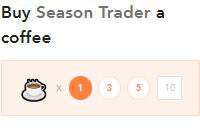Market Radar 08. December 2022
Market
Little noise about almost nothing
Yesterday at noon American time, the put call ratio measured by the CBOE jumped sharply. Stock market participants hedged with long put options. At the same time, trading volumes rose slightly more when equities rose than when stocks fell. On the one hand, the fear of falling prices is increasing, on the other hand, there were no valid reasons yesterday to sell shares massively. At the end of trading, the major US stock indices closed roughly where they opened.
The S&P 500 (SPY) closed in loss for the fifth day in a row and now looks a bit oversold.
Now negative correlation in bonds and equities?
But these five days were quite different for the bond market. The ETF for long-dated US government bonds (TLT) posted four daily gains in the last five trading days.
We may now see the beginning of a phase in which bonds and equities are negatively correlated. Actually, such a countervaility of bonds and stocks would be what we see most of the time in stock market trading. The fact that we have practically never seen this in 2022 will perhaps be considered an anomaly in later history books. If the negative correlation between bonds and equities is confirmed, many asset managers who rely on asset allocation will be able to breathe a sigh of relief: With bonds in the portfolio, it may again be possible to cushion weak days in the stock market. Balanced funds and similar products could advertise lower volatility compared to pure equity funds – which was hardly possible in 2022. And some shareholders may be tempted to shift parts of their equity positions into bonds. This “sweet temptation” alone could cause a run in bonds and a tear-off in equities at the turn of the year. Because at the turn of the year we see probably the highest reallocation activity of the year for rotation models.
Get the Seasonal Tradingsignals on you cell phone
What do we see under the radar of the major stock indices?
Industry rotations hardly took place on Tuesday. Airlines, retail, agrochemicals and industry have been downgraded from “buy or top-up” to “buy the dip”. Only Cathy Wood’s ARK ETFs and the lithium (LIT), Internet cloud (WCLD) and biotechnology (XBI) sectors receive the daily stamp “wait and see” or speculate on sell-off.
Lithium Short
In the lithium sector, I opened a rather small short position in the Canadian stock Standard Lithium (SLI). Standard Lithium explores, develops and processes lithium brine properties in the United States. His flagship project is the Lanxess project with approximately 150,000 acres of brine leases in southern Arkansas.
The company has not yet generated any sales, but this should start in 2023. The market capitalization is already around $900 million. With the first sales, the 2023 KUV is expected to be around 8. Profits are expected to increase more strongly than sales, but the company will probably not become profitable until 2025 at the earliest.
The stock is very popular among private traders and must certainly be called a hot stock.
Lithium stocks have recently come under pressure because Goldman Sachs analyst Nicholas Snowdon predicted strong temporary declines in the lithium price in a study in September. He assumed a decline of up to 80% to around $16,400. Industry experts have reacted irritated to this study and increasingly assume the opposite.
Standard Lithium testet aktuell ein drittes Mal die Unterstützung bei 3,80 $. Fällt die Unterstützung, dann dürfte es schnell Richtung 3,50 und vielleicht sogar bis 3 $ runter gehen.
Home builders need wood
In addition to my remarks on shares from the house construction segment, I would like to present today a stock that manufactures and supplies materials that are used, among other things, for house construction, but are also used by private craftsmen for conversion or renovation work in buildings.
Simpson Manufacturing (SSD; Market capitalization about $ 4 billion) is considered the world market leader for wood connectors. The company’s products are mainly used in lightweight construction and, in addition to wooden connectors, also include angles, dowels and screws, fastening systems and shear walls. At around 85%, by far the largest turnover is currently generated in the timber construction sector, while the concrete sector (15%) mainly includes connecting materials such as adhesives, metal dowels and chemical anchors for steel and concrete construction. The customers come from residential, industrial and commercial construction. In addition, Simpson offers engineering services and design software.
We find the current chart picture very interesting and also the fundamentals convince me.
Technically, the stock found its all-time high in December 2021 at just under $ 140 and fell back to about $ 77 at its peak. As of September 2022, a saucer formation has formed, which was left upwards by up-gap on November 10. The gap opening of 10 November was only briefly undercut intraday on 17 November, so the chances are good that this gap will no longer be closed; so there is a pivot breakout.
Since November 10, the stock has formed a flat basis, which is expected in such a form in charts rather below 52-week highs. At $90, the stock appears to be backed “by strong hands.” The next horizontal resistances on the chart wait at $100 and then in increments of 10 at $110 and $120
Similar to homebuilders D.R. Horton (DHI) and Toll Brothers (TOL) unveiled yesterday, Simpson Manufacturing management does not expect profit and revenue growth through 2024. The P/E ratio is around 13. Looking at the past, this world market leader for wood connectors was usually valued at a P/E ratio between 30 and 37 between 2009 and 2021. As with house builders, we also see an undervaluation compared to our own history. At Simpson Manufacturing, this seems to me to be quite large, at more than 50% below the average value of the 2010s; this means that the undervaluation is currently exaggerated.
In addition, the company is practically debt-free and, with a dividend of 1% p.a., is quite stingy in terms of its own substance. For me a top pick in the value area.

